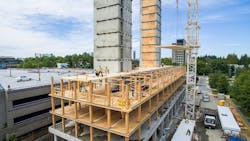Simulation Helps Virtual Construction Company Deliver on Time
This file type includes high-resolution graphics and schematics when applicable.
Simulations are critical to the design and delivery of everything from system-on-chip (SoC) systems to the latest self-driving electric cars. We use simulations to develop application software before a chip is available. Simulations can also be useful in scheduling and showing how devices and projects will fare over time.
CadMakers, a virtual construction company, leveraged Dassault Systèmes’ Catia and Enovia tools to help build the 18-story hybrid mass-timber residence at the University of British Columbia (UBC). The UBC Brock Common building, erected in nine and half weeks, uses 2233 cubic meters of wood building material. Part of this was due to CadMakers’ simulation and scheduling, as seen in this video:
This also requires many components to be employed in the proper sequence.
Part of the challenge of using CadMakers’ approach is to get the buy-in from the trades involved in the actual construction, since they’re not as familiar with the high-tech tools. Of course, seeing the benefits of the process via simulation helped immensely.
Convincing partners to use collaboration tools like Dassault Systèmes’ Enovia was key to keeping the project running smoothly. Enovia is a collaboration and product-lifecycle-management (PLM) tool that’s applicable for everything from building an 18-story hybrid mass-timber building to managing the delivery of a custom SoC.
Mass-timber projects are just some of the jobs that CadMakers has been involved with—the company used its data-driven decision-making process to simulate Kengo Kuma’s tower in Vancouver (see figure above). The glass façade is quite complex. CadMakers developed a fully integrated virtual design—including digital fabrication of the design—plus planning for construction services.
So, is mass-timber technology the world’s future building material? For now it represents a tiny part, simply because the companies that supply the materials in the fashion needed to build structures like the UBC Brock Commons building are small, when compared to those involved with existing building infrastructure.
The video below presents the start-to-finish process of building an 18-story hybrid mass-timber building:
About the Author
William G. Wong
Senior Content Director - Electronic Design and Microwaves & RF
I am Editor of Electronic Design focusing on embedded, software, and systems. As Senior Content Director, I also manage Microwaves & RF and I work with a great team of editors to provide engineers, programmers, developers and technical managers with interesting and useful articles and videos on a regular basis. Check out our free newsletters to see the latest content.
You can send press releases for new products for possible coverage on the website. I am also interested in receiving contributed articles for publishing on our website. Use our template and send to me along with a signed release form.
Check out my blog, AltEmbedded on Electronic Design, as well as his latest articles on this site that are listed below.
You can visit my social media via these links:
- AltEmbedded on Electronic Design
- Bill Wong on Facebook
- @AltEmbedded on Twitter
- Bill Wong on LinkedIn
I earned a Bachelor of Electrical Engineering at the Georgia Institute of Technology and a Masters in Computer Science from Rutgers University. I still do a bit of programming using everything from C and C++ to Rust and Ada/SPARK. I do a bit of PHP programming for Drupal websites. I have posted a few Drupal modules.
I still get a hand on software and electronic hardware. Some of this can be found on our Kit Close-Up video series. You can also see me on many of our TechXchange Talk videos. I am interested in a range of projects from robotics to artificial intelligence.




